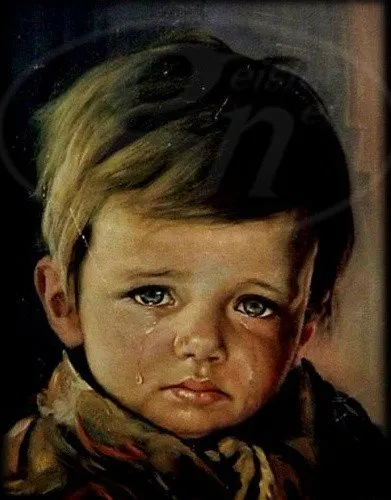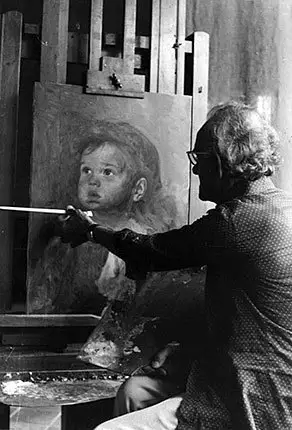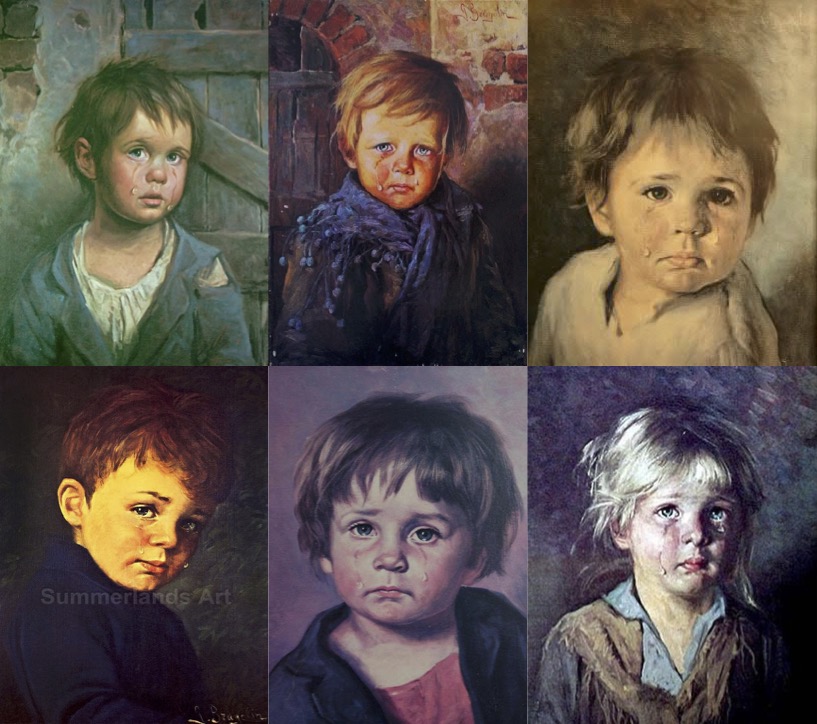Our relationship with crying is very troubled. Usually people don’t know how to deal with the act of crying, specially someone else’s. There’s an embarrassment and a sense of exposure felt by the crying person that, combined with the incapacity felt by the watcher, creates a very awkward and difficult situation. It’s almost unnatural how often this happens with such a common and human act.
This tension that comes with the observation of the crying act, made me very intrigued by a series of paintings that became popular in the 60’s and 70’s, that depicts this subject.


By the end of the XX century most Portuguese houses had the painting “o Menino da Lágrima” as decoration. This was one of a series of crying children portraits by the Italian artist Giovanni Bragolin completed in the 1950’s. Despite their sad and suffering look these paintings became very popular in Portugal, Brazil (O Menino da Lágrima), Chile, Argentina, Spain (El Niño Que Llora), Britain (Crying Boys), Sweden (Gråtande Barn), France (Le Garçon qui pleure) and Italy.
These were very melancholic paintings that marked a generation.
“a fashion that for those who were Portuguese children between the 1970s and 80s has “a load of sadness and desolation”
Público – O Menino da Lágrima, o quadro que assombrou mil infâncias e casas portuguesas (O Menino da Lágrima, the painting that haunted a thousand childhoods and Portuguese homes)
There are dozens of versions, namely “Meninas da Lágrima” (Crying Girls), and each country had its favorites or a more beloved portrait.

Their strength in the collective consciousness is so great that even those who haven’t lived directly with them recognize the name or image. “Sometimes it no longer matters whether the painting existed with us, in the place where we lived or with the people we knew, because it was there even without being there”
Público – O Menino da Lágrima, o quadro que assombrou mil infâncias e casas portuguesas (O Menino da Lágrima, the painting that haunted a thousand childhoods and Portuguese homes)
In Portugal this generational memory is so strong that has been used as an amulet, as a kitsch reference in photo sessions, tv shows’ sets, humor segments, among others, by various public figures, such as futebol players. It has even been used as decoration in hotels and object of reinterpretation by several artists.
Not only that but the painting has been seen by many as cursed, specially in Britain, where many stories aroused where the painting escaped unscathed from houses destroyed by fires.
This is a very interesting and intriguing “trend” for me. How can this crying tabu (even more so at that time) be looked at as a decorative object? How can crying children be conceived in the 60’s as an appropriate ornament for the normal household? But then again, isn’t art the best way to question society’s prejudices?
Fonts: https://www.publico.pt/2019/07/15/culturaipsilon/noticia/menino-lagrima-quadro-assombrou-mil-infancias-casas-portuguesas-1879677 (Portuguese), https://en.wikipedia.org/wiki/The_Crying_Boy and https://exemplore.com/paranormal/The-Crying-Boy (English), https://www.losandes.com.ar/por-las-redes/el-nino-que-llora-la-tragica-y-maldita-historia-detras-del-cuadro-que-todos-tuvimos/ (Spanish), https://tablodeco.fr/blogs/blog-idees-de-decoration-avec-des-tableaux/tableau-garcon-qui-pleure (French), http://www.kulturcentrumholokyrkskola.se/fragan-som-stalls-ar-varfor-har-vi-en-bild-av-ett-gratande-barn-pa-vaggen/ (Swedish)